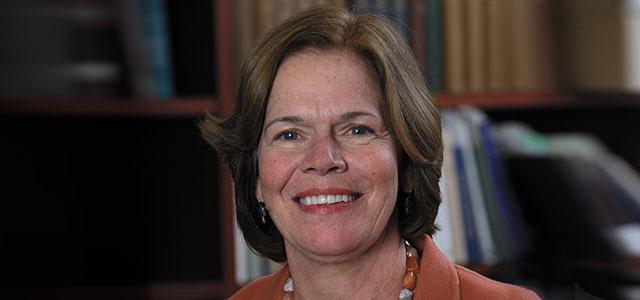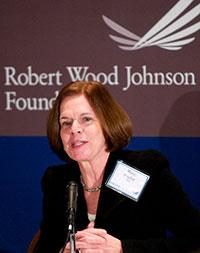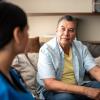
Leading the Way for Transitional Care: A Conversation with Mary Naylor
Mary D. Naylor is the UCSF Presidential Chair for 2015-2016. Dr. Naylor will be on campus for three different residency periods – the first in late October – with the goal of catalyzing interdisciplinary research, education and practice on transitions in health and health care. She will be working with representatives from all UCSF schools and the health system. Her first residency period will be from October 25-31, 2015 and it will include the UCSF Presidential Chair Keynote Lecture at the UCSF Laurel Heights campus, on October 29, from 3-4 pm in the Laurel Heights auditorium.
As the Marian S. Ware Professor in Gerontology and director of the NewCourtland Center for Transitions and Health at the University of Pennsylvania School of Nursing and architect of the Transitional Care Model (TCM) for older adults, Dr. Naylor has spent more than two decades leading a multidisciplinary team of clinical scholars and health services researchers in generating, disseminating and translating knowledge designed to enhance the care and outcomes of chronically ill adults and their families.
Science of Caring spoke with her in late July 2015.
SOC: How has the Affordable Care Act (ACA) and health care reform generally changed the country’s approach to transitional care for chronically ill older adults?
MN: The ACA offered a glide path for transitional care. Our research team and others were very engaged in helping [congressional] staff understand the body of evidence related to transitional care and how we should use this major change in health policy to advance the care of at-risk chronically ill people and families throughout common episodes of acute illness. Our collective efforts contributed to multiple provisions of the ACA focused on improving care transitions, including the CMS (Centers for Medicare and Medicaid Services) Innovation Center allocating $500 million to foster community-based care transition programs. This specific initiative is explicitly designed to highlight the importance of establishing partnerships between hospitals and community partners to meet the health needs of diverse chronically ill patient populations.
SOC: What does it mean to connect hospitals and community partners?
MN: I can best explain this by offering an example. A few weeks ago I visited a health system that is implementing the Transitional Care Model (TCM). The health system, located in an impoverished community, uses advanced practice (AP) nurses supported by other team members to deliver transitional care services from hospitals to patients’ homes. While demonstrating some improvements in outcomes, the system realized they were not achieving all that was possible, primarily because the people they were serving were unable to meet basic needs such as food, transportation or copayments for medications once they returned home. The system collaborated with a local food bank to incorporate a meal service that was adapted to the needs of people living with heart failure, diabetes or other common conditions. Now, upon discharge, each patient receives five days of nutritious meals. It’s those kinds of partnerships we are trying to foster. Today, there is a tremendous amount of innovation centered on service delivery models that connect hospitals to the communities they serve.
SOC: How do we move from encouraging pockets of innovation like this to seeing systemwide change?
MN: In addition to the “carrots” resulting in substantial investments in local health systems, the ACA also incorporates “sticks.” On the one hand, the message is to take advantage of innovation opportunities to redesign the care system, [but] with growing evidence that we can achieve better outcomes and reduce costs, disincentives also were included in the ACA to prevent avoidable rehospitalizations for common health problems such as pneumonia. Together, this combination has stimulated massive changes, including embracing evidence-based transitional care as a central component of health system transformation. Transitional care is now ubiquitous because services that promote more seamless care for vulnerable patients during high-stress transitions are now recognized as central to high-value care.
SOC: There are a lot of definitions of high-value care out there. How do you define it?
MN: Secretary [of Health and Human Services Sylvia] Burwell recently announced a plan to move Medicare’s payment system from one that rewards volume to one that promotes value. The most immediate challenge is to gain consensus on the meaning of value. I believe we need to start with what matters most to people. We need to pay increased attention to people’s needs and preferences, as well as their experiences with care. A distinguishing feature of our team’s approach has been to identify patients’ and family caregivers’ health goals and to craft a plan of care designed to achieve these goals. Reducing unnecessary, costly and sometimes harmful use of health services such as hospitalizations, while important, is only part of the challenge. We need to focus on promoting longer-term gains in health and quality of life and do so by engaging the people our health system supports as key partners in defining these measures. When aligned with people’s goals, we also need to support decisions that allow death with dignity. That’s what I mean by high-value care.
SOC: Where does your transitional care model fit in this changing environment?
MN: The TCM is a pioneer in the world of evidence-based transitional care. With nurses, physicians, health systems leaders, payers, policymakers and others, we’ve been working for years on testing complex interventions and helping to foster quality and financial incentives to implement this evidence-based care management strategy. Our team has consistently demonstrated through NIH [National Institutes of Health]-funded clinical trials that this advanced practice nurse [APN]-led, team-based care management approach results in enhanced patient experiences, improved health and quality-of-life outcomes and wiser use of finite resources. As we continue to refine this strategy to have an impact on diverse patient groups, we simultaneously are working to promote widespread use of this program.
SOC: Can you describe specifically how that evidence is being put into practice?
MN: Early in our work, health systems were not interested in this approach, primarily because incentives were not aligned. So we pursued a path – certainly not a common one – when we began to partner with interested funders, health systems, communities and payers to test implementation of the TCM in the real world. We had to design and test a set of tools for translation. Everything was so new to us, and we made many mistakes. Fortunately, we collaborated with a number of champions who helped us navigate this path.
SOC: Has there been widespread adoption?
MN: With the support of the Robert Wood Johnson Foundation, our team completed a national scan to identify how health care organizations are using evidence-based transitional care to redesign their care systems. Findings from this initial phase of our work reveal that about 60 percent of 550 respondents report using the TCM alone or in combination with other approaches. Currently, we are conducting a deep dive to understand exactly how these sites are implementing the model, what adaptations have been made and what they are learning from this work.
SOC: Do the local adaptations concern you?
MN: Adaptations are a fact of life. Our hypothesis is that many adaptations occur when local clinicians and leaders believe there is a better way to accomplish patient and/or organizational goals. As a result of a range of factors, many make these design choices to increase a program’s reach or achieve better value. Our model was never intended to be the endgame. Instead, the evidence from the TCM is a very strong foundation for change; local adaptations generally mean that the work is owned by the system. Once [the TCM is] launched, continual learning and adaptation are essential.
SOC: What are some of the biggest challenges?
MN: A major challenge is helping local systems and communities understand the evidence needed to help them know what is required to initiate real system change. An essential element for success is a culture of care that is person- and family caregiver-centered. It’s critically important to improving the care and outcomes of chronically ill patient populations to acknowledge the central role of patients and family caregivers as members of the care team. APNs, physicians, pharmacists, and other members of the team are able to influence the care of patients to the extent they know about it; ongoing monitoring is often done by others, so we need to make the investment in training family caregivers and patients in self-management.
Also needed is a commitment to a team-based approach that capitalizes on the gifts that everyone brings to the table. Good symptom management, for example, means continuously investing in building clinical competencies of APNs in patient engagement, palliative care, advanced care planning, as well as system competencies such as working in teams, continuously improving performance and managing the health of diverse populations.
To achieve improved outcomes for the growing population of chronically ill people, we need to expand team members beyond APNs and other health professionals. We need to engage all who interact with patients on their journey, including peers and community health workers. A major cultural change is acknowledging diverse roles, building competencies and promoting the confidence of emerging team members.
SOC: You’ve expanded the model to those with cognitive impairment. Can you talk about that a bit?
MN: When we started, we excluded people with cognitive impairment. After publishing reports from a number of studies, our team received a call from a colleague at the Alzheimer’s Association who challenged us, stating we really hadn’t tackled the needs of those who are among the most vulnerable patients and families – those whose care is complicated by cognitive impairment. With the support of this foundation and ultimately NIH and the Marian S. Ware Alzheimer Disease Program, we began to refine the model and were able to demonstrate positive effects, including reductions in all-cause rehospitalizations when the TCM was compared to other evidence-based interventions.
SOC: What’s next?
MN: Currently, we are focused on exploring how the TCM might add value to an evolving care system redesign. We know high-risk patients typically have multiple active chronic conditions complicated by multiple other health and social risks. Sometimes, their caregivers are chronically ill patients too. We also know that these individuals are living in our communities or receiving long-term services and supports. We have expanded application of the TCM to a variety of community-based settings such as patient-centered medical homes – each time asking the question: Does integration of the TCM within this context add value to the emerging care delivery models?
SOC: How do you intend to bring what you’ve learned to UCSF?
MN: For the past two years, UCSF leaders and faculty have undertaken considerable planning to transform the UCSF Health System, taking a full population health perspective. This means the organization must undertake advances in the organization and delivery of health services that involve the full continuum of care with seamless transitions between each level. I will bring our team’s experience to this process, serving as a catalyst to support activities across disciplines and schools around transitions in care, and provide expertise as the UCSF Health System designs and implements transitional care services for diverse populations. I look forward to the opportunity to contribute to the learning experiences of students at all levels and from all disciplines, related to their continued development as clinicians and scholars in the emerging health care system. Finally, I hope to contribute to the conversation about interdisciplinary collaboration, exploring with UCSF faculty and students how to best prepare the current and emerging workforce to actively engage in the extraordinary opportunities we have to better align our care systems to address the complex needs of high-risk populations.




